Whether you’re new to hiking or more advanced, it can be hard to know exactly what to bring on a hike to help you be prepared for the eventualities you may face on the trail.
It doesn’t matter if it’s a shorter hike or a longer, full day adventure, being prepared with several day hike essentials will help you enjoy the views more and spend less time feeling uncomfortable!
In this article, we go through everything from trekking poles and hiking shoes to waterproof rain jackets and hiking compasses. In reality, we always like to say that you can easily go with what you already have and make any adjustments to your gear and equipment as and when you need it.
If you’re just starting out, this can get costly quite quickly, so it doesn’t need to be complicated!
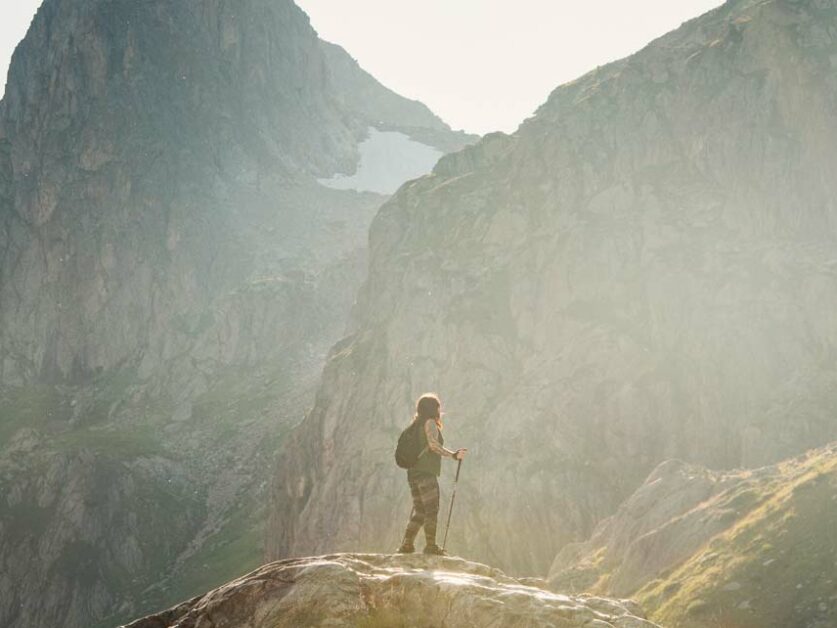
General Hiking Checklist You can use this list for year round basics | Winter Hiking Checklist Look at adding these items depending on your location | Spring Hiking Checklist Look at adding these items for changeable weather | Summer Hiking Checklist Look at adding these items to be prepared for hotter temperatures | Fall (Autumn) Hiking Checklist Look at adding these items to be prepared for shoulder season |
Hiking boots or shoes Hiking socks Hiking pants, shorts or leggings Base layer Mid layer Top layer/rain jacket Day pack Water bottle or hydration pack Food & snacks GPS, map, compass Sun protection First aid kit Headlamp Trekking poles Toilet supplies Additional items: Camera Powerbank Fire making kit Insect repellent Add New | Waterproof hiking shoes or boots Gaiters, crampons or micro spikes Ice axe Merino or synthetic long sleeved base layer Merino or synthetic leggings/tights Buff or scarf Lined hat or beanie Gloves (waterproof) Thermal water bottle Waterproofs (pants, jacket) Winter hiking trousers More layers Sun cream with high SPF Glacier glasses/goggles Snow shoes Hiking poles | Sunglasses Peak cap or wide brim hat Beanie hat Slightly lighter layers/puffy Rain jacket/rain pants Trousers that can be changed into shorts More water Crampons Sun cream | Sunglasses Peak cap or wide brim hat Bug spray and after bite stick Breathable, quick drying and moisture wicking layers Sun cream More water – consider bigger containers, more than one or a high-capacity bladder/reservoir Electrolyte tablets or sachets More snacks you enjoy A meal you enjoy that will keep well in your pack in direct sun (depending on length of hike) | Sunglasses Higher capacity of water Bug spray and after bite stick Electrolytes Gloves Hiking poles Micro spikes/crampons Peaked cap or wide brimmed hat Beanie hat Light mid layers Rain jacket and rain pants Trousers that can be made into shorts Sun cream |
What Footwear and Clothing Should You Bring on a Day Hike?
Wondering what to pack when hiking can vary depending on where you’ll be hiking and the time of year. For example, you wouldn’t bring trail runners for day hiking in the snow.
So, thinking about where you’ll be and what you’ll be doing, and the complexity of the trail is the most important thing when looking at a hiking equipment list for your personal needs.
Use our lists below as a guide and take and add what works for you – it’s always a good idea to air on the side of caution, whilst being careful not to overpack.
Hiking Shoes or Walking Boots
There is a division amongst hikers around what to take hiking between those who prefer hiking shoes and those who prefer a walking boot. Even here at This Expansive Adventure, we’re divided on which we prefer.
Whilst your footwear choice is personal preference to some degree, a lot will also depend on where you plan to hike, the time of year and the type of trail you are likely to encounter.
Let’s go through the pros and cons of each:
Hiking Shoes
One of the immediate pros of hiking shoes is that they can present a much more lightweight option – many people would say that they are in fact must have hiking gear. In fact, we asked our team the question ‘if you were going on a hike, what 3 items would you make sure to bring?’ and the top answer was pretty much always ‘a good pair of hiking shoes, a good mid layer and a well-fitting backpack’. Hiking shoes do, in many ways allow you to move more quickly along the trail – their lightweight nature in comparison to boots means you are more agile and quickly able to respond to the feel of the trail.
They’re great in most scenarios weather wise – but they can fall down in much boggier or muddier weather. So, this is a certain con, and if you know you’re hiking a lot in places with deeper mud or very sharp rock, you may be better going with hiking boots. Likewise, if you know you are a little less sure footed, they aren’t the greatest for protecting from things like rolled ankles and even more serious sprains.
More well maintained or looked after trails work great with hiking shoes, but if you know you’re likely to be making your own trail or traveling on trails less frequented, then hiking boots may still be your best option.
There are so many different options out there when it comes to hiking shoes, from ultralight trail runners which offer fantastic breathability but less rigidity. All the way through to serious alpine shoes that offer incredible traction, waterproofing and support without having the weight of a boot. With this in mind, we’d recommend reading our guide to hiking shoes and our how to choose the right hiking shoes article too. However, at a glance, we’d recommend the Salomon X Ultra 4 GTX Hiking Shoe.
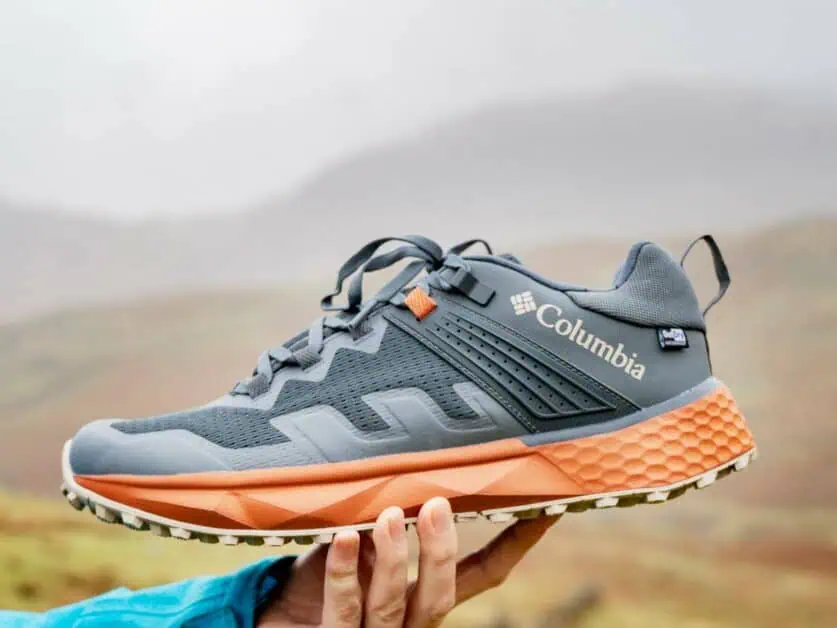
Walking Boots
The most obvious pro of a hiking boot is the extra level of support they provide. Going further up the ankle and often with a much chunkier thread, construction and waterproofing, they are more versed for a range of different scenarios.
They’re also great for colder, wetter, and boggy conditions and they’re also good for hybrid or shoulder seasons. We say if you don’t know what you are going to get from a trail, a walking boot is probably what you need for hiking.
Likewise, if you’re someone who is a little less stable on the trail, hiking boots might be a better option for you, and they can give you a greater sense of confidence.
That said, one of the big cons of hiking boots is they can feel like overkill in a range of scenarios. For example, if you’re going to be hiking on well-maintained trails in hotter locations, they can feel heavy, cumbersome, and hot due to a lack of breathability.
Walking boots have gone on a journey and manufacturers are constantly working to improve technology to provide boots that have exceptional performance in a similar way to what you’d expect from a hiking shoe, so there are plenty of options out there.
Some of our notable favorites are the Danner Panorama Mid as a kind of light, hybrid boot, and the Salewa Alp Trainer 2.
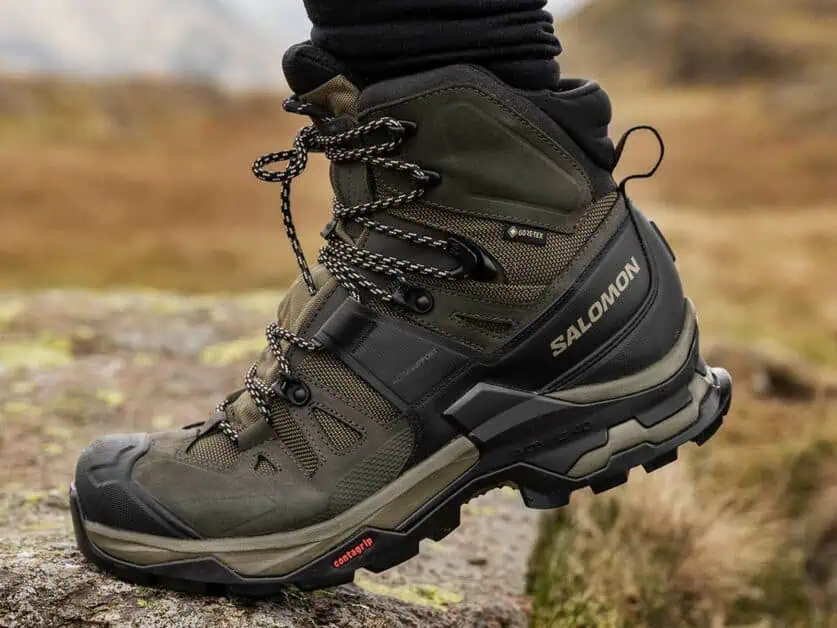
Hiking Socks
Often overlooked, but an item that should be pretty much at the top of your hiking check list are good socks. What you go for will depend, and a lot of this will be decided by how you’ll use them and how often – as hiking socks can get quite pricey.
Purpose built hiking socks are designed to wick moisture which helps to take the sweat away from your feet meaning you won’t get blisters or sore spots so often. This can be extremely helpful on longer day hikes or in warmer temperatures. They’re equally great in colder temperatures too, as they keep your feet warmer for longer.
Finding the right hiking sock for you should be decided by what footwear you plan to wear and when you’re hiking. If you’re wearing a boot, its usually a good idea to go for a slightly thicker sock. Likewise, a shoe usually needs a lighter weight sock. If hiking in winter, go for a thicker sock, and in summer, it makes sense to use a thinner one.
Some hiking socks use merino wool in their construction, whereas others use synthetic materials. Merino wool is efficient at moisture wicking, and you can even wear merino socks for days (which is great for backpacking) but if you don’t want animal fibers, look at synthetic. Our favorite options are Darn Tough and Sealskinz.
Whilst purpose designed hiking socks are generally the best option, if your budget doesn’t quite stretch, any good sports socks will do the job well enough.
Hiking Pants
Hiking pants are a fairly broad spectrum but getting them right should be an important part of your hiking essentials list. What to bring depends on the kind of hiking you want to do and personal preference.
There are three main areas you can look at when it comes to hiking pants:
Hiking trousers or pants
These are usually constructed from synthetic materials and provide much better protection from the elements than a standard pair of jeans, jogging bottom or tracksuit bottom. They also often have moisture wicking properties too. They can really vary in price, with some being better suited to alpine (better knee padding). We’d say go with whatever softshell is in your budget. This will keep you well looked after in most circumstances – we recommend The North Face Paramount Pants. You can also add a pair of fully waterproof rain pants if you know you’ll be hiking in rainy conditions a lot. If they’re just for protection, keep a pair in your bag and opt for a pair that are fully zipped for easy access. We’d recommend the Rab Downpour Eco Pants.
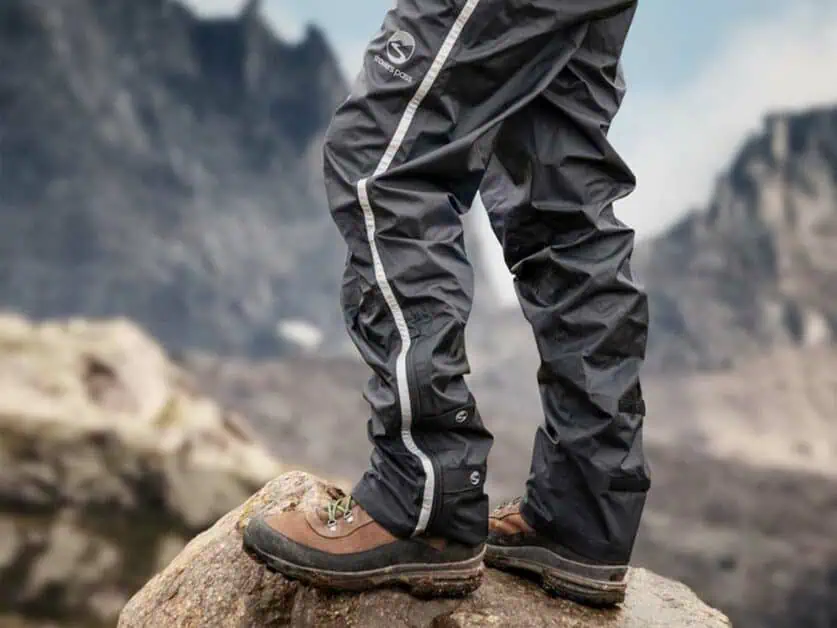
Shorts
We generally prefer a full-length pant when hiking as they provide better protection, but depending on the circumstances, shorts can work really well too for warmer weather. Many brands will offer a soft-shell variant of their pants as a short and some offer their pants with a zipping feature to turn from trousers into shorts. Go for a soft shell, quick drying option where possible.
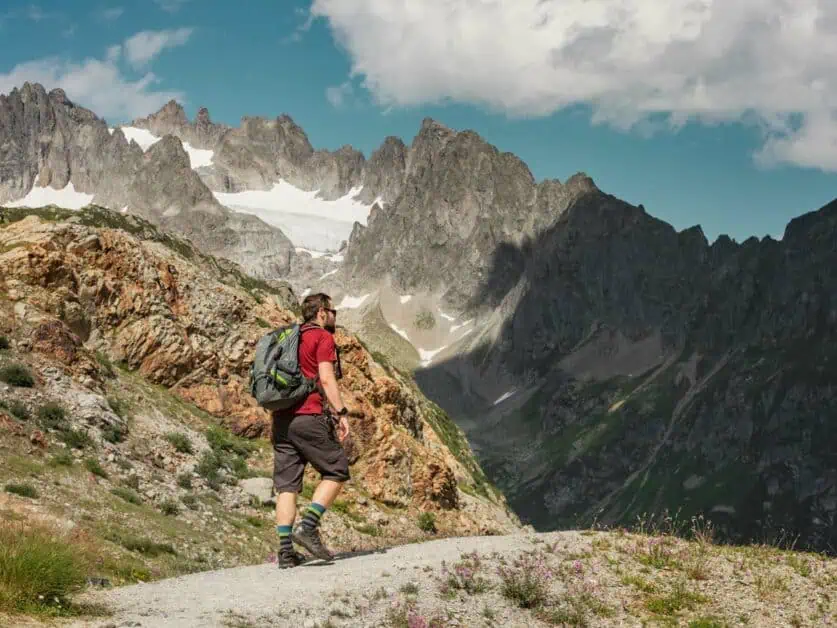
Leggings
Many will say leggings ‘aren’t proper hiking gear’ but that really isn’t true – they make great day hiking gear. You should ultimately wear what you’re comfortable with, and besides, many brands have worked to create specific hiking leggings that are extremely comfortable to wear and provide adequate protection in many circumstances. Sure, you aren’t going to get quite the same level of protection as a softshell, and you will still struggle to get leggings suitable for extremely wet circumstances or deep winter, but it is possible to get lined leggings and three season specific pairs too. Go for a pair that are moisture wicking and with pockets. We recommend the Eddie Bauer Trail Tights which are comfortable and come in a great range of sizes.
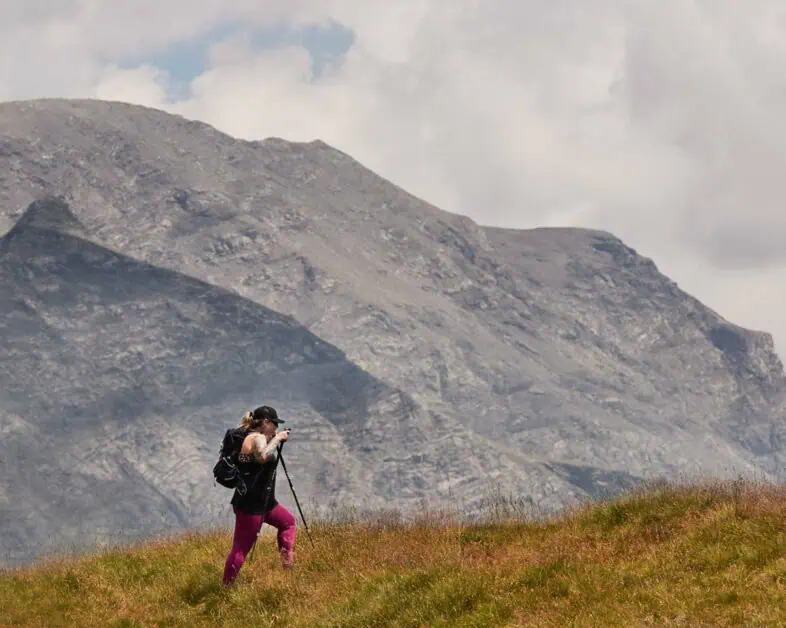
Base Layer
For maximum comfort, a good base layer should be one of your day hiking essentials. This should either be a synthetic t-shirt or vest top specifically for hiking or a longer sleeved merino base layer. The decision about which one is best for you will be decided by where you’re hiking. A synthetic t-shirt or vest top is better for warmer temperatures, and they’re also quick drying so can withstand showers.
A merino base layer is a better fit for your day hike gear when colder temperatures hit and it’ll will give you an extra layer of insulation when hiking in winter, for example. They’re also fantastic for moisture wicking which also makes them a great option for warmer temperatures too. For both options, go for something with synthetic fibers over cotton.
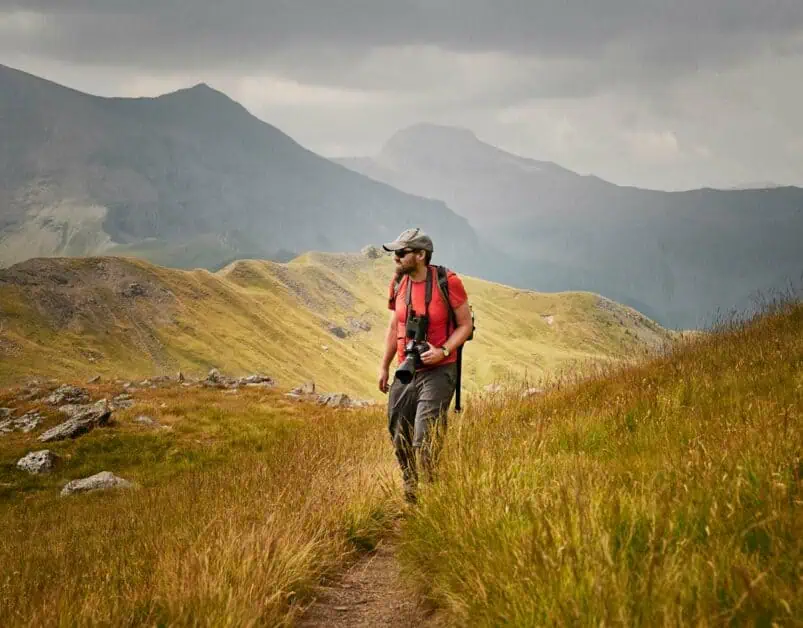
Mid Layer
Your mid layer will depend a lot on the temperature of where you’ll be hiking, but it is also best to make sure you have several layers that you can take on and off to regulate your temperature throughout the day.
Like many hiking items, there are plenty of options here. You could go for something as simple as a moisture wicking jumper – something synthetic that gives you that extra layer of warmth and can easily be taken off.
Another option on your hiking list for a mid-layer is a fleece layer or synthetic style light jacket or hoody. These can either come as a fully zipped up option or a neck zip which works as a pullover. It’s best to go with one that is fully zipped as it’s easier to open on the trail and self-regulate temperature wise.
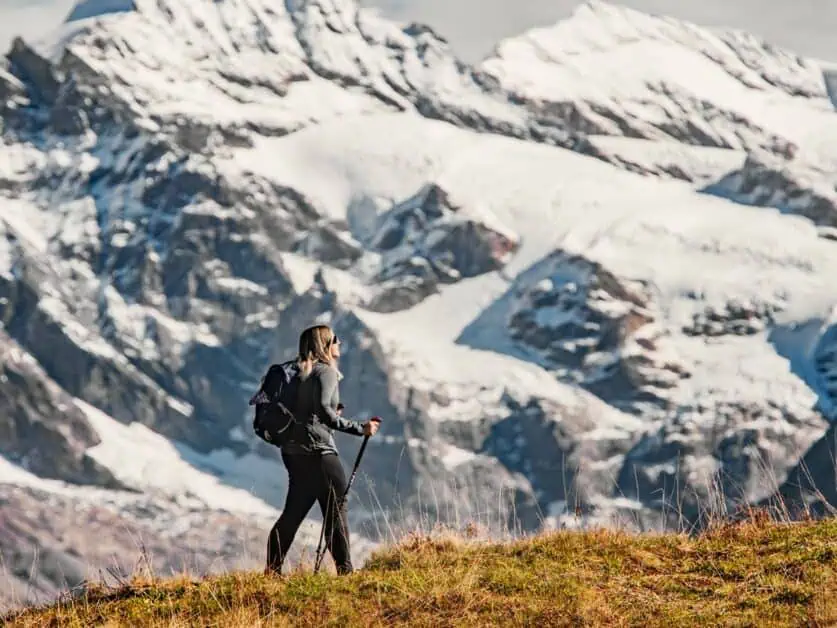
A puffy jacket is a hiking must have for many, and for a lot of hikers, this is where their top half layering system will finish. This is dependent on the weather – for example in cold but Mediterranean style alpine environments, you might find this gives you perfect insulation. We advise going for something that is thinner, but allows excellent insulation, so you can layer up if you need to rather than something much thicker.
A great hybrid that we love is something like the Rab Xenair Light Jacket which provides lightweight insulation and protection from the elements, is warm and thin so doesn’t have you feeling bulky when wearing with other layers.
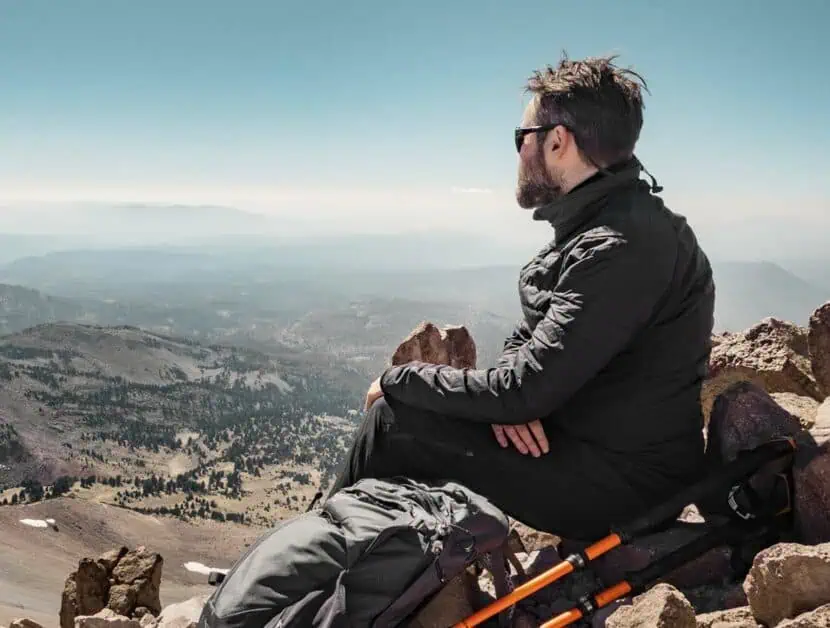
Top Layer
A top layer is usually a hard shell – this is less breathable than your mid layer (which you may stop at depending on your circumstances) but it provides more protection from the elements. It can also work as a wind breaker too – depending on if the top layer you have, has these properties. Some top layers will be fully waterproof and make use of a membrane. Whilst others may just be water repellent or not water resistive at all (which will allow it to be more breathable).
When looking at the things to bring on a hike, your top layer decision should be made by thinking about the climates you’ll be hiking in, or plan to hike in. Whilst it is always a good idea to have a waterproof rain jacket, it may be overkill for you if it doesn’t rain a lot where you are or where you plan to go.
To help you decide the level of water resistance you need, we also recommend reading our article Water Resistant vs Waterproof vs Water Repellent – What is the Difference.
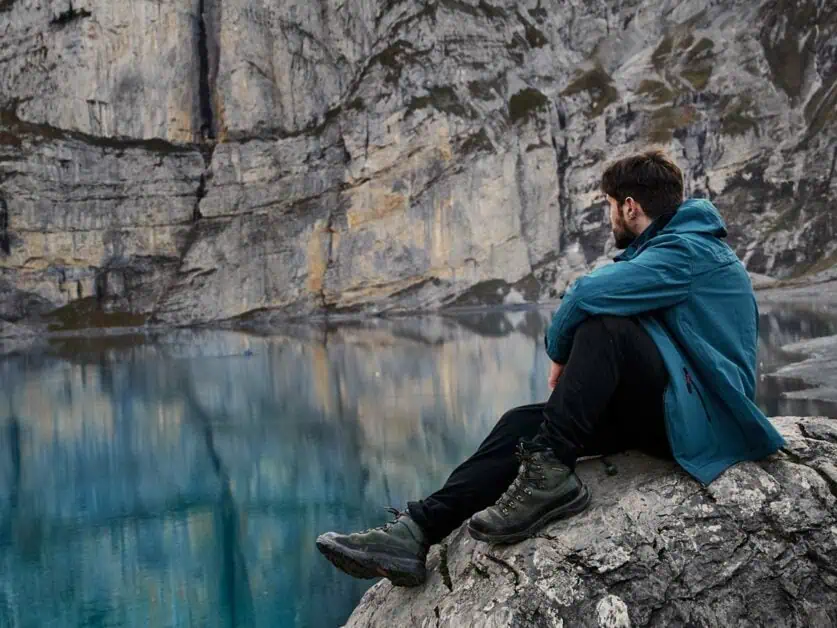
Waterproof Rain Jacket
Many would consider a waterproof rain jacket one of the essentials things to take hiking. Others might consider it overkill and say you only need a hard shell. We think this depends completely on the level of rain you can expect on your hikes. If you don’t know, air on the side of caution.
We generally prefer our top layer to be a hard shell that is also a waterproof rain jacket, however we also have different waterproof rain jackets for summer versus winter (summer being thinner, winter being thicker and hardier to the elements).
Buy the best you can afford when it comes to a rain jacket – and if you know you aren’t going to use it that much and it’s just going to sit in the bottom of your backpack in case a lot of the time, pay special attention to the packability of the rain jacket you go for. We’ve reviewed a whole range of different options in our guide to waterproof rain jackets, and you may also want to check out our waterproof rain jackets buying advice article for more information here to help you choose.
What is the Essential Equipment for a Day Hike?
Making a day hike packing list should be pretty simple once you’ve got a hold of the basics, and once it’s packed you can generally keep it mostly that way until you head off next time.
Your hiking supplies will generally depend on your individual needs – for some people it will be more of a creature comfort or something for a specialist activity like a tripod for photography, bird watching or gear for cold water swimming. What one person classes as an essential another won’t, so don’t let our list dictate yours – use it as a starting point.
That said, you can’t go wrong with having the items listed below, or variations of them on your hiking packing list.
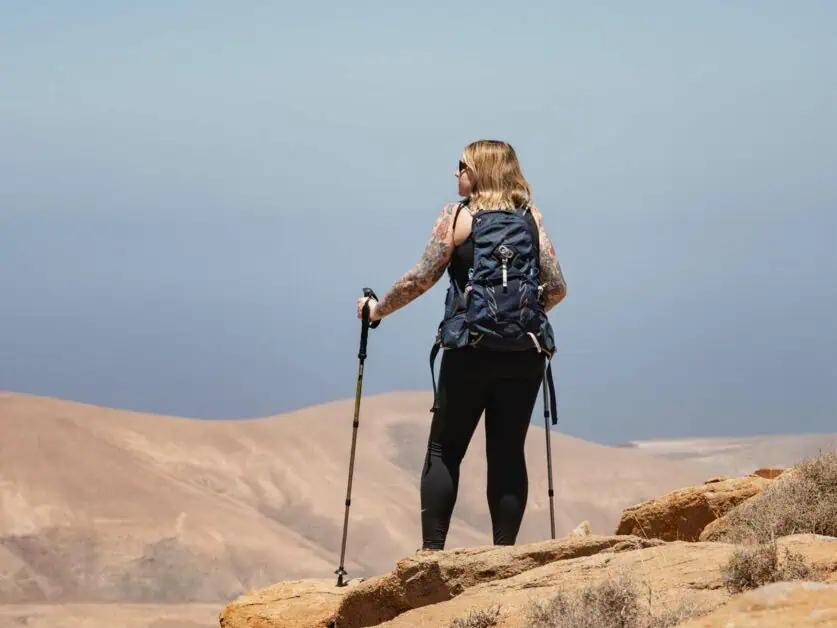
Daypack
Whilst you can of course get by without one, a backpack is pretty much a hiking essential. When you’re going to be out for any amount of time, you’ll want access to various bits of your kit and it also helps keep you prepared should certain situations arise or weather changes whilst you’re outdoors.
When you’re looking at getting the best backpack for your needs, the size that you go for is important, as something that is too big may overwhelm you and stop you from moving as fast as you’d like. Something that is around 20 to 30 liters is perfect as it will allow you to keep all of your basic hiking gear packed away without feeling like too much,
If you do find you need to carry slightly more to keep you safe against things like bad weather or winter scenarios, then going for something a little bigger – into the 30 something liter range may be better for you.
This is a personal choice. We often find ourselves using larger day packs due to carrying camera equipment. We’d recommend either the Osprey Talon 22 (Men’s) or the Osprey Tempest 20 (Women’s).
If you have accessibility needs, it may be worth talking to your hiking partner to ask them how they feel about carrying most of your equipment in a slightly larger pack. This can make a big difference to your fatigue on the trail and can allow you to go further. Likewise, you could opt for a much smaller day pack or an over shoulder smaller pack, with the aid of your hiking buddy helping with some of your heavier items.
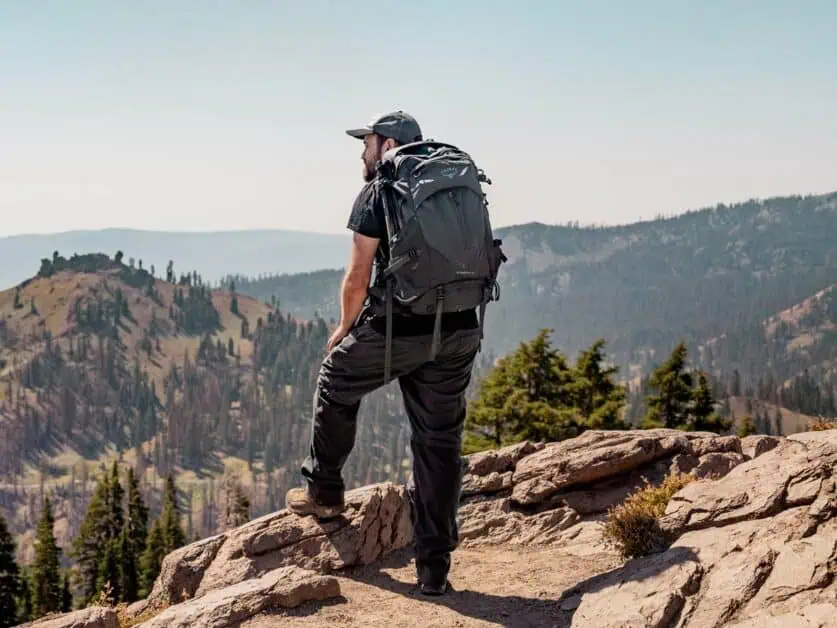
Fluids – Water Bottle, Hydration Bladder or Water Purification System
Water is of course essential for keeping you hydrated for your hike – and a water bottle is a pretty much tried and tested solution and a favorite by a lot of hikers for it’s ease and accessibility.
There are a lot of options on the market, such as an insulated design which will keep any fluids cool for a longer period – but they can be pricy and they do add weight. There are also more traditional models out there, such as Nalgene which is a much cheaper option. They are reliable, but they don’t keep your drinks cold which is something to consider if you hike in warmer weather.
Most hiking bags will have side pockets or a compartment which is specifically designed for keeping water bottles in.
Another thing to consider is a hydration bladder or a hydration reservoir which allows you to drink your water on hike hands free. This is a great option to take out the annoyance of stopping every time you need a drink. This is really helpful on more strenuous hikes where you might expect to need to hydrate more.
You’ll find that some hiking packs are built with space to fit a hydration bladder and they’ve become a really popular choice as a hiking must-have. We like the Osprey Hydraulics LT 2.5L system.
In both circumstances, we recommend about 2L of water per day – though this depends on how far you’re hiking and the temperature, this could be more or less depending on your trail. Always take more water than you’ll need with you.
While it’s not always necessary for a day hike where you’ll likely be able to bring enough water with you from the start, it’s still wise to carry water purification tablets or a small filter as part of your things to take on a hike. If you know you’ll be hiking near fresh streams or similar, this can dramatically cut down on the amount of water you need to bring with you, which can be heavy.
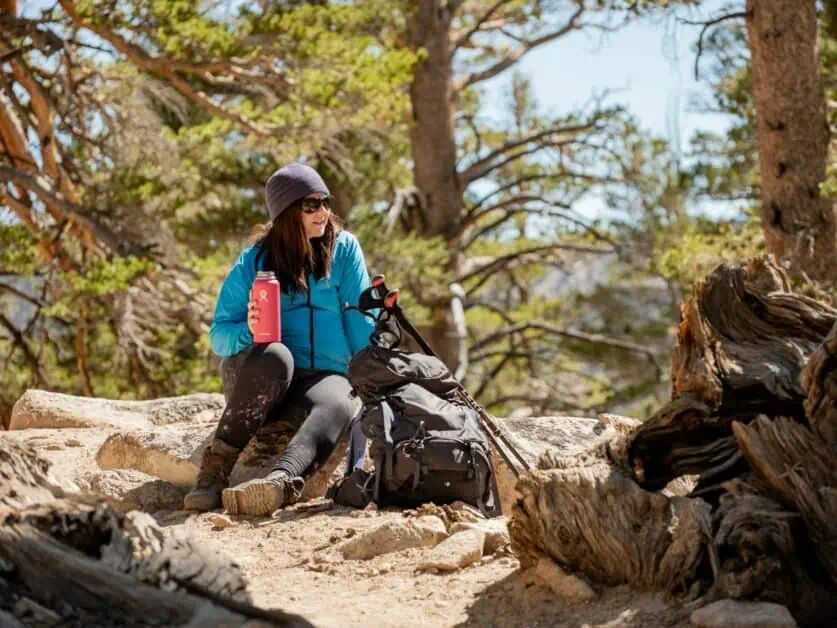
Food
You may have heard that phrase ‘I only hike to eat snacks with a good view’ and whilst that might not be entirely true for you, food is such an important thing for us – and especially hikers. You’re exercising constantly so you need to keep refueled to have enough energy for the trail and to avoid fatigue. Next to water, food is one of the most important things to bring hiking.
We recommend about 300 calories an hour – but this doesn’t mean you need to be eating every single hour – for example, your breakfast, if prepped properly will allow you a lot of the nutrients and calories you need and then you can top up by eating lunch on the trail. Bring some snack bars too.
The food you bring with you should be things you want to eat – especially if hiking at altitude which can have a real impact on your appetite. We recommend combining carbs with protein – pasta with protein and veggies is always a winner for us, as is a trail burrito. Use a well-fitting air tight container and wrap it in a plastic bag or small packing cube/flexible dry bag to keep it away from the rest of your hiking backpack essentials.
In Winter and Fall/Autumn, you may also want to consider bringing something warm – our guide to freeze dried meals for backpacking goes through this in more detail with many options that are suitable to keep you warm and fueled up for day hikes too.

Navigational Tools – Map, Compass, GPS Device
There are several things we would consider as essentials when it comes to what to pack for a day hike where navigation is concerned. A GPS device is likely going to be overkill when it comes to spending a day on the trail and an app on your phone with your map downloaded is likely your best bet. This is our preferred method, and if you keep your phone charged and have back-up, this will work well for you and is easy to follow.
That said, we believe there is still space for a paper map and hiking compass as an essential item for hiking. If you’re always heading off on very popular trails with a clear path, then this may be overkill, but you have to think about eventualities like getting lost, there being nobody else on the trail and if you’re hiking in more remote areas. It’s always better to play on the side of safety than not. A good hiking compass will not add much weight to your pack – but you should also learn how to use it and read a map before heading out too.
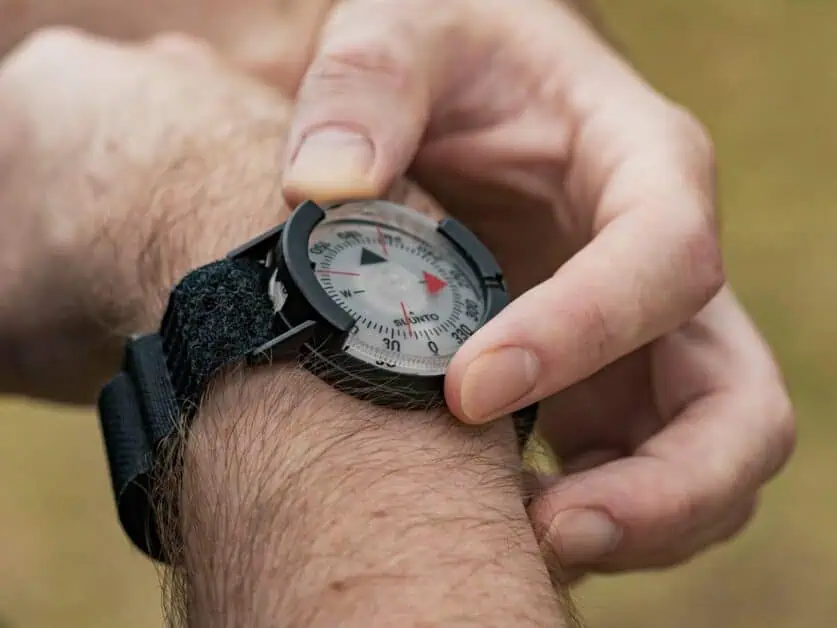
Sun Protection
Depending on your hiking conditions, a vital section on your day hiking checklist should be sun protection. This should be in the form of:
- A hat: This could be either a wide brim hat or a peak cap, depending on your preference.
- Sunscreen: You should cover the parts of your body exposed well once you start hiking. Go for a sweat resistant sun screen when deciding what to pack for a hike. You should reapply frequently depending on your sweat level and sun exposure. If you’re at altitude, you should invest in a higher SPF sun cream as the UV exposure is increased. If you plan to go swimming whilst you hike, get a biodegradable sunscreen to help protect the biodiversity of the area you’re swimming in. Many general sun lotions can contain harmful microplastics.
- Sunglasses: We always prefer a pair that have a chord connecting so you can wear them like a necklace. This is one of our hiking trip essentials as they’re great at staying put when you’re moving about a lot! Go for a polarized frame too. We love the Julbo Camino Glacier Glasses. They may be an investment, but they last for years!

First Aid and Emergency Kit
When thinking about what to bring on a day hike, you should generally be looking to bring a small emergency first aid kit. This is to help protect you from any small injuries on the trail.
You don’t need anything elaborate or complicated here, just a few basic items to keep with you for safety. You should make sure you include a few things like bandages, gauze pads, adhesive tape, antiseptic wipes, tweezers, scissors and something for pain relief like ibuprofen. This is also a good place to store any extra medication you need to bring with you.
Another good item to put in this pouch are blister plasters, but you should always tailor your day hike packing list when it comes to first aid based on where you’ll be visiting and the kind of terrain you’ll encounter.
Headlamp or Flashlight (Torch)
Whilst you’ll likely find you don’t use it all that often a headlamp is a really great addition to any hiking day pack list. It’s a really useful tool if you plan on some sunrise hiking or equally a sunset hike. It’s also a valuable thing to have if your hike goes on longer than planned.
We generally think a simple, lightweight rechargeable headlamp such as the Petzl Actik Core is a perfect day pack essential. We’ll usually go for this over a flashlight. Why? It’s just easier to use. It can sit on your head, so you don’t have to carry it. They’re directional and just a lot less hassle to use and keep your hands free.
At a push, your phone light will do the job, but remember that this will wear the battery down – not ideal if you’re using an app for your GPS!
Trekking Poles
Trekking poles can be a great addition to your kit – some people may say they’re not an essential, but for other people they can be extremely important. They’re especially good if you have any pain issues or just need that little bit extra support on the trail. They also help a lot with the pain you may experience in your back and knees after a steep downhill too.
What do you need to look for in hiking poles? Of course, go with what your budget will allow, but we would recommend a pair of lightweight collapsible, foldable poles like the Leki Makalu FX Carbon AS. These fold down really small and can attach to your backpack as opposed to some of the chunkier versions that stick really far out of your pack. We have a whole guide to buying trekking poles within various budget ranges, and for more information, be sure to watch our video guide below on how to choose the best trekking poles for your needs.
Toilet Supplies
A good, old fashioned roll of toilet paper, a baggie and a shovel can work well if you need to go on the trail. Scented poo bags also work well, too! Be sure to take this away with you and always dispose of your waste in a trash can! If your hiking pack has a mesh pouch on the front, we’d recommend keeping your toilet essentials there to keep them breathable and away from other items.
One of the backpack hiking essentials we’d also recommend for people who squat or crouch when peeing is a pee cloth – such as a Kula Cloth. This washable cloth is microbial, so it doesn’t smell and is one of the most environmentally friendly ways to go in the outdoors. It also fastens to your pack to air, doesn’t show stains and comes in several great designs.
What Other Things Could You Take on a Day Hike?
Many of the items on this day hike checklist are non-essentials so to speak, and more ‘nice to haves’. You can also add your own items that you may like to bring here. You should also look at the extras, away from some of the basics we’ve outlined above based on your location and where you plan to go hiking.
What you need for a hike will really be determined by this – for example, you wouldn’t necessarily bring crampons or micro spikes with you for a hike in the desert! Likewise, you’re unlikely to want to bring insect repellent if you are hiking in the snow. So adapt this list based on your needs.
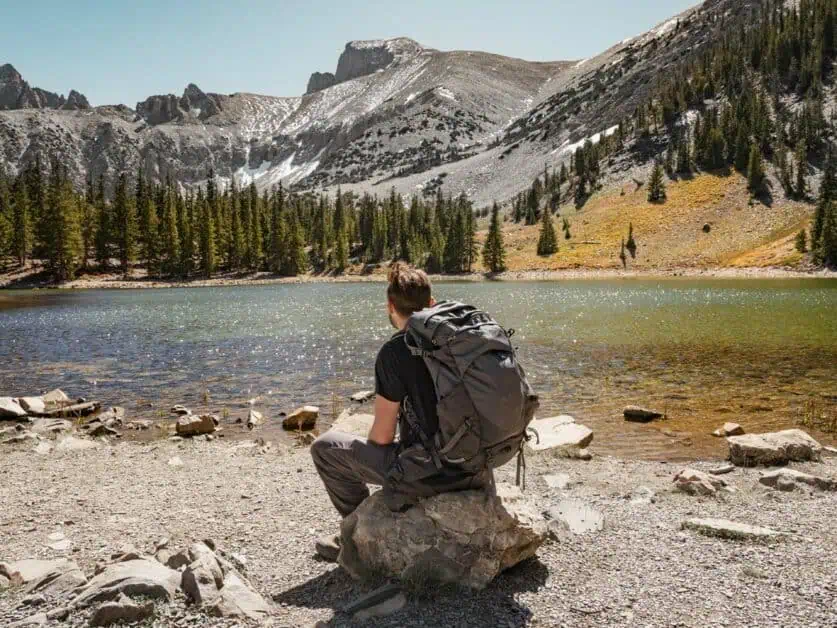
Camera
We’re maybe not the best people to ask about camera equipment as we naturally bring loads because photography is a really important aspect of our hiking at This Expansive Adventure! However, if you really want to capture those amazing scenes you get to experience, stepping up from your phone camera to a purpose fit SLR can be a great addition to your basic hiking equipment.
We’d advise going for a mirrorless camera – these are more lightweight than traditional mirrored SLR digital cameras. Depending on your interest, you might also want to add some lenses at different focal lengths – we love longer lenses for picking out details in landscape scenes. Likewise, you may want to consider adding a tripod to your day hike gear list.
When you start bringing photography gear, it does bulk out your pack and so it’s worth considering whether you’ll need a higher capacity backpack to distribute the weight evenly. You may want to look at a pack offered in over 30L.
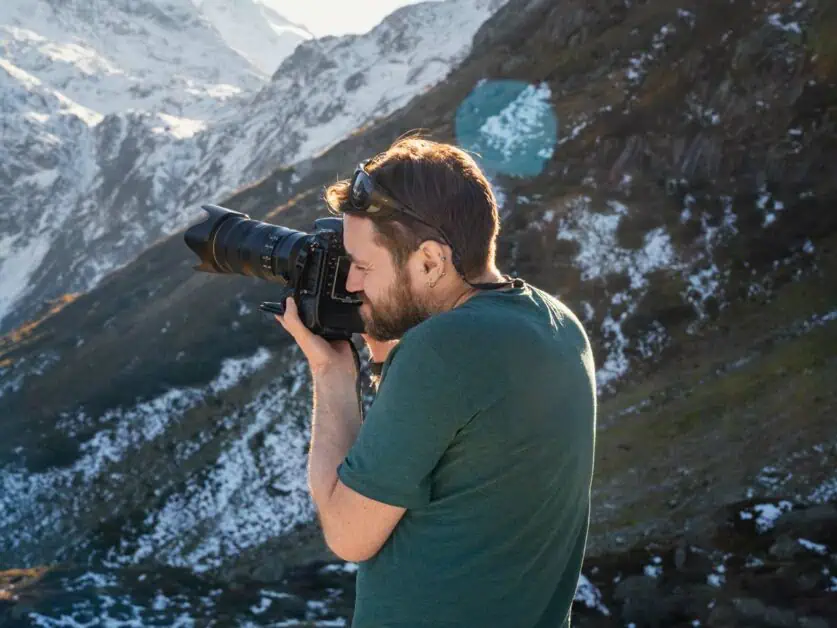
Power – Batteries, Solar Charger or Powerbank
When you’re working on your hiking trip packing list, some essential equipment for hiking are batteries, a solar charger or a power bank. This is a good idea to keep your devices charged and working for your hike to prevent any problems.
Batteries are really important as well when it comes to devices like flashlights, GPS and some headlights. You should always plan to have more power than you think you need in case your devices run out, just in the same way that you plan to bring extra food and water.
One thing you can consider is a solar charger which can give you a good backup. Including these items in what to pack for a hiking trip means you’ll keep prepared just in case and be able to focus on the trail rather than thinking about batteries.
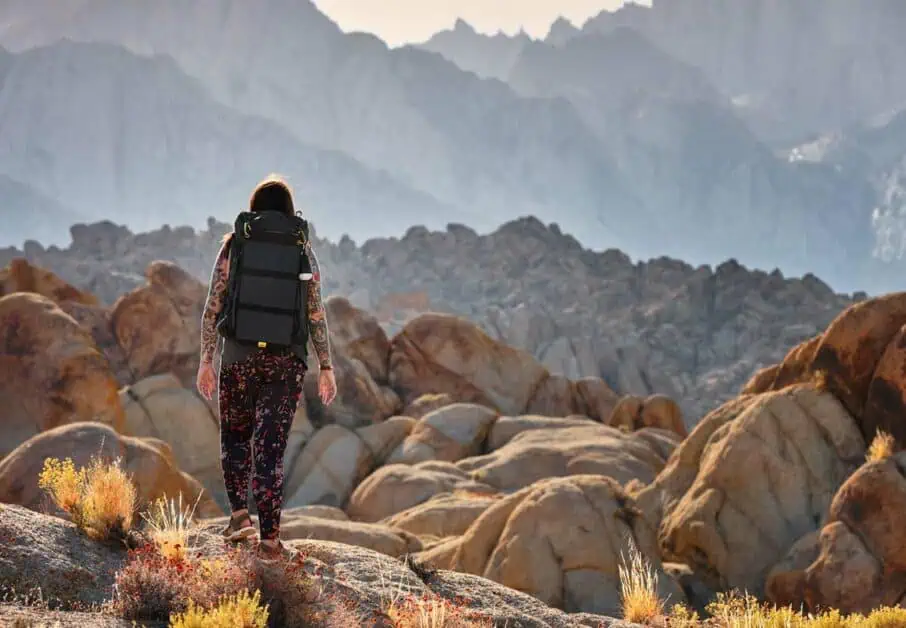
Fire Making Kit
A fire making kit is something you can also consider adding to your hiking pack list just in case of any emergencies or in case of circumstances you didn’t plan for.
This might seem a little over the top, and in many circumstances isn’t needed, but having this can provide warmth, a signal or even cook your food in case of an emergency.
This only needs to be basic – something like waterproof matches, a lighter or small fire starter that only takes up a small amount of space can be a really great additional to your existing day hiking gear list.
Naturally, you should always practice Leave No Trace principles when starting a fire – and never start a fire in a wild fire prone area or an area where fires are prohibited. It’s also important to see if the area you’re planning to hike needs you to have a permit to light a fire. This information can usually be found out either in a tourism information center or on the National Park or similar website.
Insect Repellent
This is really dependent on where you hike and can be completely season dependent. Insect repellent may be a vital part of your hiking day pack, or it also may not.
The most obvious is that it helps to create a barrier against insects like mosquitoes, ticks and flies. If you go hiking in areas where there is greater humidity, or near water sources it can be really important from stopping getting bitten and becoming itchy.
When you’re buying insect repellent for hiking, you want as formula that makes use of either DEET, picaridin or similar to keep you protected.
You will also want to consider that certain lotions and sprays are tailored to different geographic regions, so get one that is suitable for the area you’ll be hiking and the bugs there.
Generally, you want a long-lasting formula. If you plan to go wild or cold-water swimming whilst hiking (who doesn’t love a peaceful alpine lake) be sure that the formulation you’re using is biodegradable to prevent damage to the biodiversity of the body of water you’re entering (the same goes for sunscreen).
Depending on location, including insect repellent in what to pack for hiking will give a more comfortable and fun time outdoors away from itchy and painful bites!

Miscellaneous Items and Extras
Depending on where you’re hiking and when, here are some other items you may want to consider in your daypack essentials:
- Tissues
- Sunglasses
- Allergy meds/spray
- Bear spray (check location rules beforehand)
- Small bear can (for any scented items, though day use hikers can generally store these at the trailhead in a bear vault)
- Lip balm or lip sun cream stick
- Swiss army knife
- Whistle
- Whistle or bell
- Bivvy bag
- Duct tape
- Plastic bag (if anything leaks)
How Does Your Day Hiking Packing List Change with the Seasons?
It should be no surprise that your hiking backpack contents will change as the seasons do – this is mostly due to differing weather conditions and how the terrain that you’re hiking through changes through the year.
What you need for hiking in summer is different to the needs for winter. In summer, you will likely bring lighter clothing, there will be more water in your pack, there’s likely more sun protection. Whereas in winter or colder climates, you’ll be bringing more layers, waterproof gear and also things like crampons and micro spikes.
If you are traveling for a hike, then you should check out the climate where you’ll be visiting beforehand. Do this in good time to give yourself enough time to put your kit together.
Below we’ve gone through some of the things you will want to keep in mind and any additional extras or changes you’ll need to make for each season.
Winter
In winter, most areas can expect cooler temperatures, some with significant snow. You’re also going to expect less light and shorter days so you should be prepared for this. Here are our alterations, amendments, and additions you should make to your things needed for hiking in winter. Of course, this should be adapted for your location.
- Waterproof hiking shoes or boots
- Gaiters, crampons or micro spikes
- Ice axe
- Merino or synthetic long sleeved base layer
- Merino or synthetic leggings/tights
- Buff or scarf
- Lined hat or beanie – something lined with fleece is always nice!
- Gloves (waterproof where possible, but that still allow movement)
- A thermal bottle for a warm drink
- Waterproofs (trousers, jacket)
- Winter hiking trousers
- More layers (depending on temperature, you may want to look at increasing the fill of your mid layer and adding a thicker puffy jacket, for example)
- Sun cream with a higher SPF
- Glacier glasses/googles
- Snowshoes
- Hiking Poles
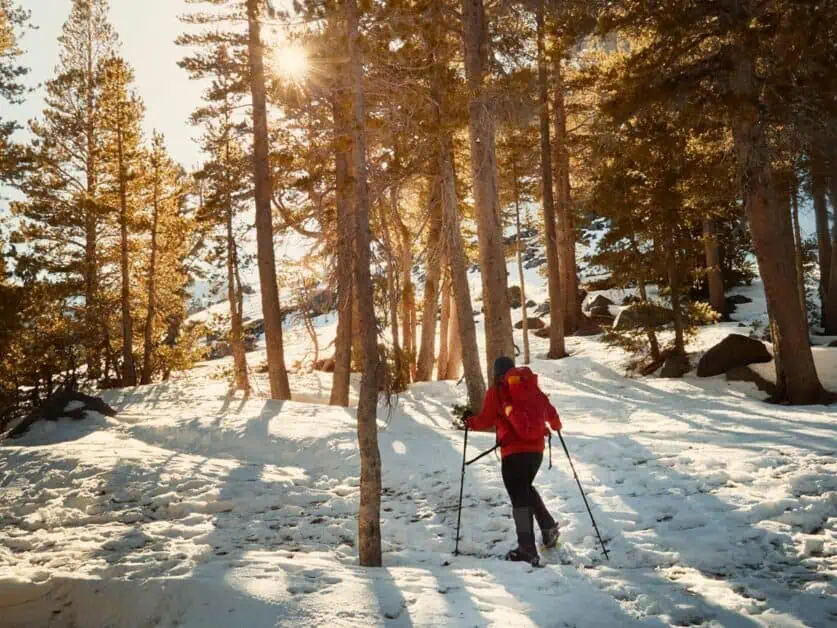
Spring
In Spring, you should be prepared for changeable weather. In the high mountains, this can be an unstable time, and in other locations, such as the desert, it can become much hotter. In some locations it can also bring a lot of rain, so what to pack for hiking can become unstable. In Spring, we’d recommend keeping certain ‘zones’ of items together in your pack – so items that are more Winter focused can go together, whereas items that are more Summer focused can sit together too. This makes it much easier when needing to change up on the trail.
Here are some items to consider bringing/changing or amending in your hiking pack for Spring:
- Sunglasses
- Peaked cap or wide brimmed hat
- Beanie hat
- Slightly lighter mid layers – lighter puffy
- Rain jacket and rain pants
- Trousers that can be made into shorts
- More water
- Crampons
- Sun cream
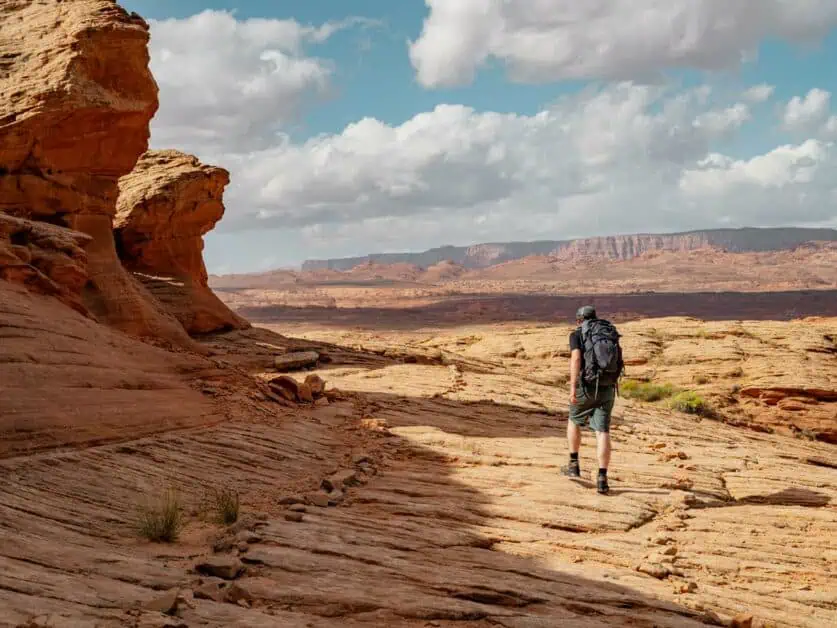
Summer
In Summer, you want to be prepared for the weather to be much hotter – so there is more of an emphasis on protection from the sun and hydration. You may also want to consider things like minerals that are sweated out – so electrolytes are always a good idea. Summer can also bring out a range of different bugs and insects too, so being protected from itchy bites will be a life saver. If you’re visiting or hiking in the high mountains, which are much more accessible generally in summer, you will want to consider how the altitude may affect you too. For example, you may find yourself less hungry at altitude and less likely to eat and refuel, so it’s a good idea to bring snacks and other foods and drinks that you really look forward to and enjoy. However, make sure it’s food that will withstand being in direct sun.
Here are some suggestions/amendments for what to bring when hiking in Summer:
- Sunglasses
- Peaked cap or wide brimmed hat
- Bug spray and after bite stick
- Breathable, quick drying and moisture wicking layers
- Sun cream
- More water – consider bigger containers, more than one or a high-capacity bladder/reservoir
- Electrolyte tablets or sachets
- More snacks you enjoy
- A meal you enjoy that will keep well in your pack in direct sun (depending on length of hike)
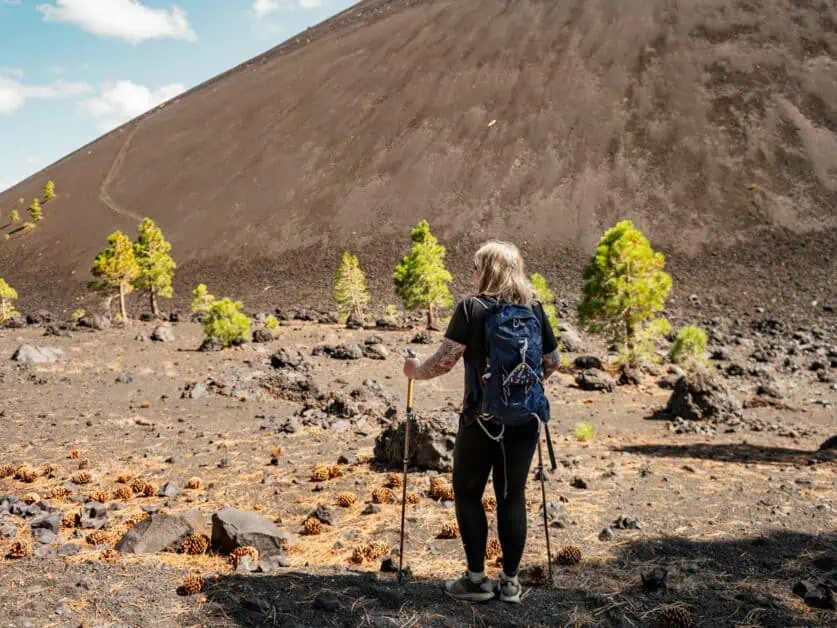
Fall (Autumn)
In many ways, your packing list for Fall and Autumn are going to be very similar to Spring. Shoulder seasons generally present similar weather, so to speak, and you will want to be prepared for changeable weather. In some locations you may see very little change in temperature, but others it can be the start of snow – and also the beautiful fiery colors in the foliage! Mountain hiking equipment may differ – you’ll likely see snow starting to appear.
What do you need for a hike in Fall (Autumn):
- Sunglasses
- Higher capacity of water
- Electrolytes
- Gloves
- Hiking poles
- Micro spikes/crampons
- Peaked cap or wide brimmed hat
- Beanie hat
- Light mid layers, becoming heavier in winter
- Rain jacket and rain pants
- Trousers that can be made into shorts
- Sun cream
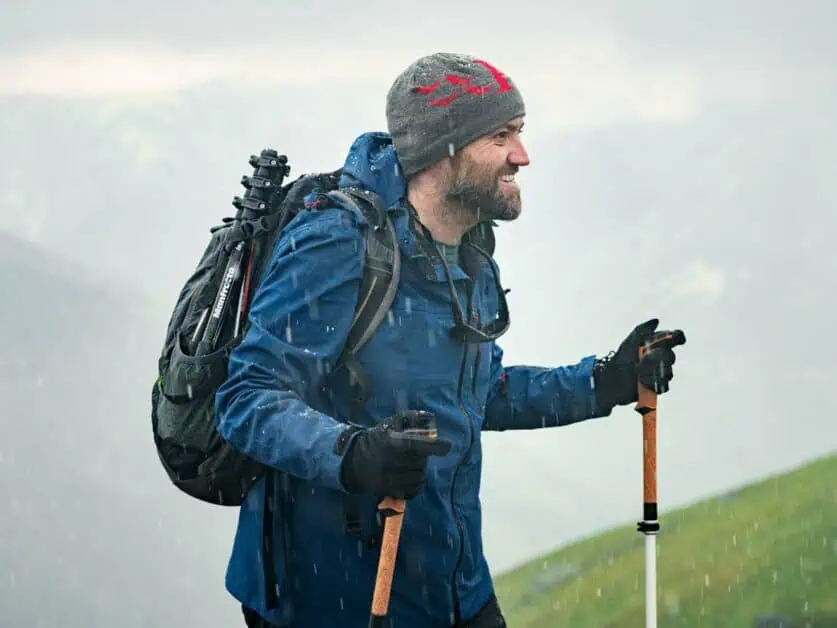
Disclaimer: This article contains Affiliate Links. You won’t pay any more for buying through these links, but we may receive a commission from any purchases made through them. As an Amazon Associate, I earn from qualifying purchases. If you choose to support us by buying through our links, we thank you as it helps us to continue providing the resources we do to help you enjoy the outdoors more!
